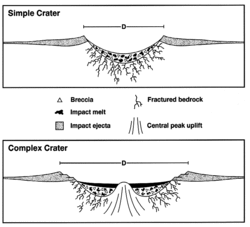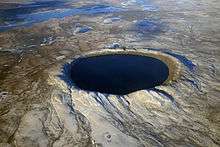Ejecta blanket

Ejecta blanket from Hadley crater filling in Hadley Rille
An ejecta blanket is a generally symmetrical apron of ejecta that surrounds a crater; it is layered thickly at the crater’s rim and thin to discontinuous at the blanket’s outer edge. [1]

structure of impact craters, showing surrounding ejecta
After an impact event, the falling debris forms an ejecta blanket surrounding the crater. Approximately half the volume of ejecta falls within 1 crater radius of the rim, or 2 radii from the center of the crater. The ejecta blanket becomes thinner with distance and increasingly discontinuous. Over 90% of the debris falls within approximately 5 radii of the center of the crater. Ejecta which falls within that area is considered proximal ejecta. Beyond 5 radii, the discontinuous debris is considered distal ejecta.[2]
References
- ↑ David Darling. "ejecta blanket". The Encyclopedia of Astrobiology, Astronomy, and Spacecraft. Retrieved 2007-08-07.
- ↑ French, Bevan M. (1998). "Ch 5: Shock-Metamorphosed Rocks (Impactites) in Impact Structures". Traces of Catastrophe: A Handbook of Shock-Metamorphic Effects in Terrestrial Meteorite Impact Structures. Houston: Lunar and Planetary Institute. pp. 74–78.
This article is issued from Wikipedia - version of the 12/8/2014. The text is available under the Creative Commons Attribution/Share Alike but additional terms may apply for the media files.
